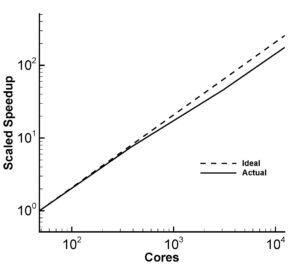We actively research new governing models and numerical methods to ensure that our tools for exploration of fundamental and applied fluid problems are at the cutting edge. We have several in-house compressible and incompressible computational fluid dynamics (CFD) codes, allowing us to rapidly implement and validate new numerical methods and governing models. This page showcases some of the recent advancement pioneered by the group.
Incompressible Flow Algorithms – Curvilinear Coordinates on a Staggered Mesh
We have recently developed a new staggered mesh curvilinear coordinate scheme for incompressible flow. The scheme has been incorporated into PUFFIN and is currently being used to study flow around river bends.
The video shows the development of flow through a periodic sinusoidal channel visualised by vorticity.
For more information, please contact: Assoc. Prof. Michael Kirkpatrick.
Flow through a periodic sinusoidal channel visualised by vorticity
High-Order Compressible Flow Algorithms
A particular focus of this research has been the development of very high order accurate schemes that can be applied to compressible flows at all speeds in industrial geometries with multiple species and be easily parallelisable.
Our key advancements include:
- a low Mach correction which substantially improves the ability of Godunov-type scheme to resolve both low Mach number turbulence and strongly compressible features such as shock waves.
- a new governing model for compressible mixing problems including dissimilar gases, demonstrated to be an order of magnitude faster for the same computational effort
- a fast solver for low Mach number computational aeroacoustics
A visualisation from a simulation of a compressible turbulent mixing layer run using our low Mach corrected scheme is shown on the right.
Below are some key references:
B Thornber, A Mosedale, D Drikakis, D Youngs, RJR Williams “An improved reconstruction method for compressible flows with low Mach number features” Journal of computational Physics 227 (10), 4873-4894, 2008.
B Thornber, M Groom, D Youngs “A five-equation model for the simulation of miscible and viscous compressible fluids”, Journal of Computational Physics 372, 256-280, 2018
L Yu, S Diasinos, B Thornber “A fast transient solver for low-Mach number aerodynamics and aeroacoustics”, Computers & Fluids 214, 104748, 2021
For more information, please contact: Assoc. Prof. Ben Thornber.
Massively Parallel Simulations
All USyd CFD codes are massively-parallelised and run efficiently on the local cluster ‘Borg’, the University cluster ‘Artemis’ and the national facilities ‘Magnus’ and `Gadi’. The group has a number of projects with substantial CPU hours granted on Artemis, Gadi and Magnus. This enable researchers within our group to routines run computations on several thousand cores at once.
The strong and weak scaling of the USyd algorithm Flamenco up to 20k cores on the NCI Gadi facility is shown in the image on the right.
For more information, please contact: Assoc. Prof. Ben Thornber.

Flamenco weak scaling up to 20k cores